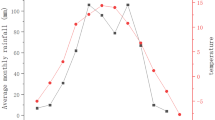Abstract
Translational landslides are common in China, particularly in the interbedded mudstone sandstone sequence of the Three Gorges reservoir area and the Sichuan basin. The paper discusses the genetic mechanism and limit equilibrium criterion for single and multi-translational landslides based on physical model tests and numerical analysis. It focuses particularly on the generation of hydrostatic pressure and uplift pressure under intense rainfall conditions and the corresponding deformation and failure processes. A model was constructed based on the actual conditions at the 17 million m3 Fengdian Kualiangdzi landslide and the 25 million m3 Tiantai village landslide. It revealed a clear relationship between the critical water head value and the dip angle of the sliding plane.
Résumé
Les glissements plans sont communs en Chine, en particulier dans la série de grès et d’argilites de la région du réservoir du barrage des Trois Gorges, dans le bassin du Sichuan. L’article présente les conditions de déclenchement de ces glissements ainsi que les critères d’équilibre limite pour des glissements plans simples ou multicouches, à partir de tests sur modèles physiques et d’analyses numériques. Il s’intéresse en particulier à la génération des pressions interstitielles et aux pressions de soulèvement résultant de pluies intenses, ainsi qu’aux processus de déformation et de rupture qui en découlent. Un modèle a été construit, correspondant au glissement de Fengdian Kualiangdzi de 17 millions de m3 et au glissement du village de Tiantai de 25 millions de m3. Il a révélé une relation claire entre une valeur critique de charge hydraulique et l’angle de pendage du plan de glissement.

















Similar content being viewed by others
References
Chen HK, Tang HM (2002) Research on start-up of loose landslide in Lab. J Mt Sci 20:1–5
Chen H, Dadson S, Chi YG (2006) Recent rainfall-induced landslides and debris flow in northern Taiwan. Geomorphology 77:112–125
Cheng SG, Luo XQ (2004) Study on criterion of similarity of rainfall slope model. J China Three Gorges University (Nat Sci) 26:506–508
Corominas J, Moya J (1999) Reconstructing recent landslide activity in relation to rainfall in the Llobregat River basin, Eastern Pyrenees, Spain. Geomorphology 30:79–93
Floris M, Bozzano F (2008) Evaluation of landslide reactivation: a modified rainfall threshold model based on historical records of rainfall and landslides. Geomorphology 94:40–57
Fukuzono T (1985) A new method for predicting the failure time of a slope. In: Proceedings of IVth international conference and field worshop on landslide. Tokyo, pp 145–150
Guzzetti F, Cardinali M, Reichenbach P, Cipolla F, Sebastiani C, Galli M, Salvati P (2004) Landslide triggered by the 23 November 2000 rainfall event in the Imperia Province, Western Liguria, Italy. Eng Geol 73:229–245
Jakob M, Weatherly H (2003) A hydroclimatic threshold for landslide initiation on the North Shore Mountains of Vancouver, British Columbia. Geomorphology 54:137–156
Kong JM, Chen ZS (1989) The translational landslide in red stratum located in east Sichuan in July, 1989. Landslide column (9). The China Railway Publishing House, Beijing, China pp 36–42
Lourenço Sérgio DN, Sassa K, Fukuoka H (2006) Failure process and hydrologic response of a two layer physical model: implications for rainfall-induced landslides. Geomorphology 73:115–130
Mikoš M, Četina M, Brilly M (2004) Hydrologic conditions responsible for triggering the Stože landslide, Slovenia. Eng Geol 73:193–213
Okura Y, Kitahara H, Ochiai H, Sammori T, Kawanami A (2002) Landslide fluidization process by flume experiments. Eng Geol 66:65–78
Reid ME, LaHusen RG, Iverson RM (2000) Debris-flow initiation experiments using diverse hydrologic triggers. In: Wiezorek ME, Nasser (eds) Debris-flow hazards mitigation: mechanics, prediction, and assessment, pp 1–11
Shi YC, FengWK, Feng XG, Lan G (2003) Study on mechanism of deformation failure of a low-angle dip beding slope of national highway No.108 by physical model test method. J Chengdu Univ Technol (Sci Technol Edit) 30:350–355
Wang GH, Sassa K (2003) Pore-pressure generation and movement of rainfall-induced landslides: effects of grain size and fine-particle content. Eng Geol 69:109–125
Wu SM, Li RG (1994) Study on numerical simulation of the landslide groups in Wanxian County. Hydrogeol Eng Geol 6:14–17
Xu Q, Huang RQ, Liu TX, Fan XM (2006) Study on the formation mechanism and design of control engineering for the super-huge Tiantai landslide, Sichuan province, China. IAEG2006 Engineering geology for tomorrow’s cities, pp 3–602
Ying KL, Jian WX, Zhou CM (2005) Study on the mechanism and prevention project of the translational landslide in Wanzhou district. China University of Geology, pp 153–154
Zhang ZY, Wang ST, Wang LS (1994) The analytical principle in engineering geology. Beijing Geological Publishing House, Beijing, China, p 304
Zuo BC, Chen CX, Liu CH, Shen Q, Xiao GF, Liu XW (2004) Research on similar material of slope simulation experiment. Rock Soil Mech 25:1805–1808
Acknowledgments
The work was supported by the State Key Laboratory of Geohazards Prevention and Geoenvironment Protection. The authors would like to thank Prof. Niek Rengers for revising the article and his many helpful suggestions, which have improved the clarity of the paper; Prof. Zhuoyuan Zhang for his critical suggestions; Xiujing Yu for technical assistance on the physical model testing.
Author information
Authors and Affiliations
Corresponding author
Rights and permissions
About this article
Cite this article
Fan, XM., Xu, Q., Zhang, ZY. et al. The genetic mechanism of a translational landslide. Bull Eng Geol Environ 68, 231–244 (2009). https://doi.org/10.1007/s10064-009-0194-1
Received:
Accepted:
Published:
Issue Date:
DOI: https://doi.org/10.1007/s10064-009-0194-1
Keywords
- Translational landslide
- Hydrostatic pressure
- Uplift pressure
- Limit equilibrium criterion
- Critical water head




